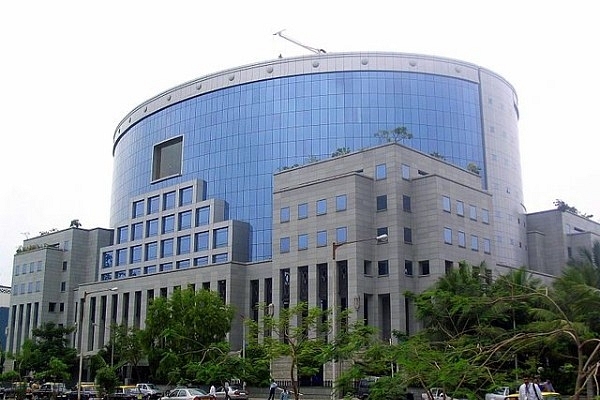Economy
IL&FS Downgrade: Why A Bailout May Not Be Easy To Come By
- Infrastructure Leasing and Financial Services Ltd recently lost its investment grade rating, something that could potentially hinder future capital raising.
- But what has caused this crisis at IL&FS? Here’s some help.

IL&FS headquarters at the Bandra Kurla Complex in Mumbai (Sumedh Kadoo/Wikimedia Commons)
Infrastructure Leasing and Financial Services Ltd (IL&FS) has been in the news recently with questions raised over the company’s debt servicing abilities. The infrastructure conglomerate’s debt has been downgraded recently by rating agencies ICRA and CARE Ratings. As a result of the downgrade, the infrastructure giant no longer carries an investment grade rating, something that could potentially hinder future capital raising.
But what caused the crisis at IL&FS, especially when the conglomerate enjoyed a AAA rating – the highest rating grade – till a short while ago?
It should be noted that IL&FS has been registered as a ‘Core Investment Company’ with the Reserve Bank of India (RBI), as a result of which its operations are restricted to investing in other group companies. Data suggests that the company has 23 direct subsidiaries, 141 indirect subsidiaries, including special purpose vehicles (SPVs), six joint ventures, and four associate companies.
Reports have stated that the company had in recent years been pursuing a ‘conceive, develop, and sell’ model, and issues started arising when there was a delay in monetising projects. It is said that IL&FS, like other infrastructure companies, expanded too rapidly in the boom years and a subsequent slowdown in the pace of project execution led to the current debt pile-up.
Former RBI governor Raghuram Rajan, in his note to the Parliamentary Committee on Estimates, had also flagged exuberant expansion and projections by companies as a key reason behind the mounting non-performing assets (NPAs) on banks’ books.
It is reported that most of the stress on the books of IL&FS has its origins in the group company IL&FS Transportation Network (ITNL). ITNL, which has a large number of projects under execution, is reported to have funded a large part of these projects through debt, leading to a corresponding rise in its debt-to-equity ratio. Furthermore, issues with monetising completed projects and a delay in claims settlement have all led to the build-up of stress in the company books.
Comparisons have been made of the unfolding situation at IL&FS, with the state of affairs occurring 10 years back at the time of Lehman Brothers going belly up. The reason for such comparisons lies in the fact that rating agencies till recently had not acknowledged the precarious financial condition of IL&FS, nor was there particular clarity on the specific exposure for banks and financial institutions.
Alarm bells have started ringing particularly loudly since IL&FS defaulted on a Rs 1,000 crore short-term loan taken out from the Small Industries Development Bank of India (SIDBI). It is reported that a subsidiary company also defaulted on a Rs 500 crore loan taken out from the same development finance institution. These defaults are especially disconcerting as IL&FS has a track record of being a serious player in the infrastructure space with a pan-India presence.
Adding to the pall of fear currently surrounding the future prospects of IL&FS is the fact that an estimated Rs 5,756 crore worth of debt has to be paid within the next one year.
Banks in India are currently struggling with a mountain of bad debt on their books and it is said that some of ITNL’s debts have been labelled as standard in the books of banks while the reality is that they are non-performing. A reclassification and provisioning exercise would spell further trouble for an embattled banking sector, and fears have been expressed over the ripple effects that will be felt by the wider economy.
While the situation does appear dire, there may still be reason to believe that the company’s operations could be salvaged. According to reports, the board of IL&FS is slated to meet on 15 September, and efforts are expected to be made to seek approval for the raising of Rs 3,000 crore as loans from the Life Insurance Corporation of India (LIC) and the State Bank of India (SBI). In fact, a look at the ownership structure of IL&FS would reveal that LIC is the largest stakeholder in the company, and other reputed organisations like Japan-based Orix Corporation and Abu Dhabi Investment Authority (ADIA) have significant stakes as well.
With LIC being a major stakeholder in the company, calls have been repeatedly made in various quarters for a bailout by the public sector behemoth. However, a bailout may not be as simple as it looks like because questions are bound to be raised as to whether public money is going to be used to bail foreign investors out, considering the large stakes that entities like Orix and ADIA have in IL&FS.
The coming few weeks will throw more clarity on the situation unfolding at IL&FS and whether India’s financial sector would have to brace itself for another crisis.
Support Swarajya's 50 Ground Reports Project & Sponsor A Story
Every general election Swarajya does a 50 ground reports project.
Aimed only at serious readers and those who appreciate the nuances of political undercurrents, the project provides a sense of India's electoral landscape. As you know, these reports are produced after considerable investment of travel, time and effort on the ground.
This time too we've kicked off the project in style and have covered over 30 constituencies already. If you're someone who appreciates such work and have enjoyed our coverage please consider sponsoring a ground report for just Rs 2999 to Rs 19,999 - it goes a long way in helping us produce more quality reportage.
You can also back this project by becoming a subscriber for as little as Rs 999 - so do click on this links and choose a plan that suits you and back us.
Click below to contribute.
Latest